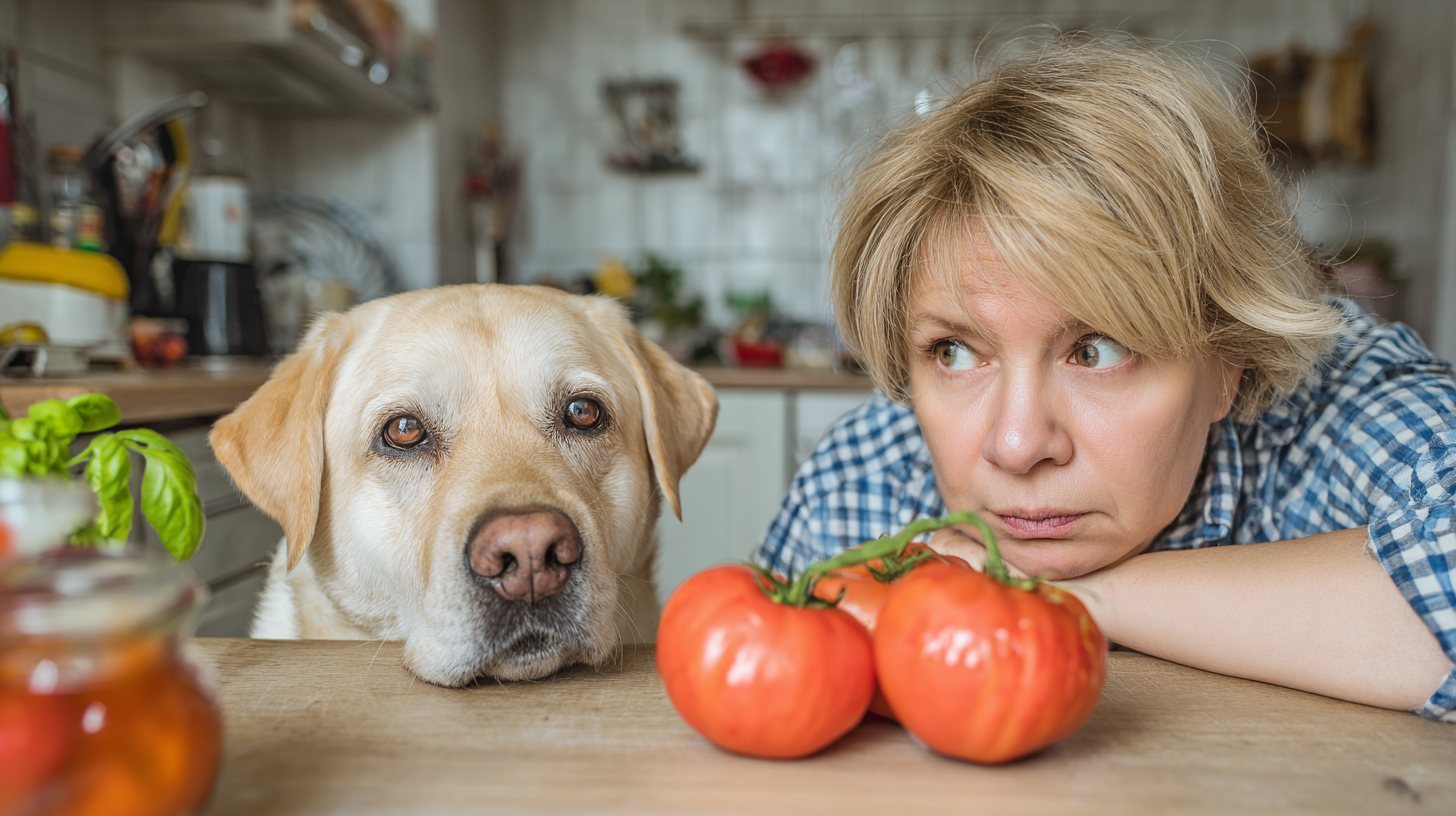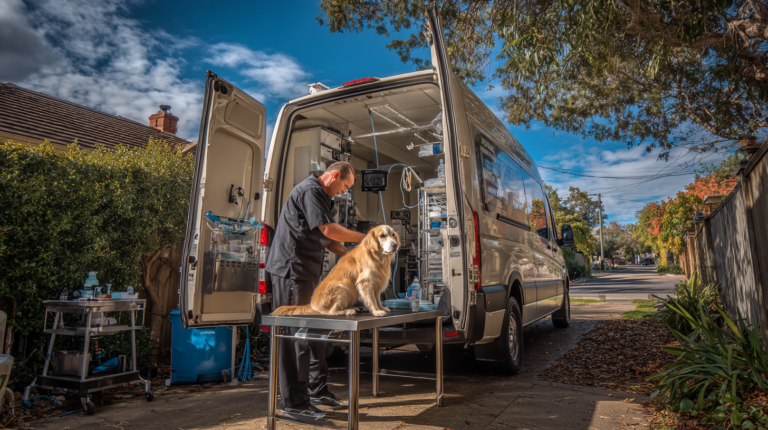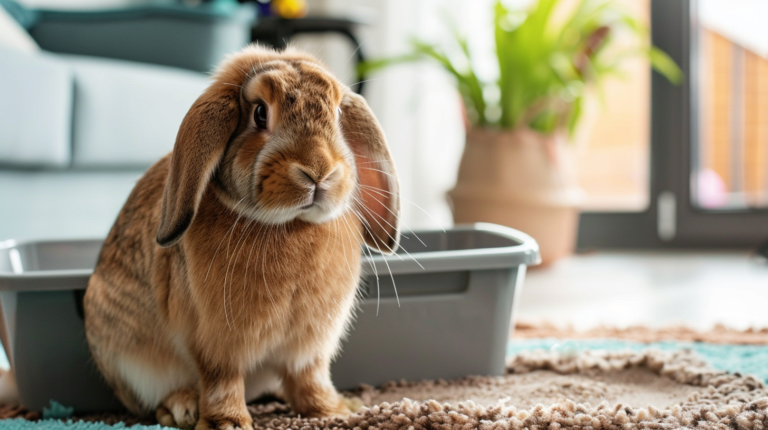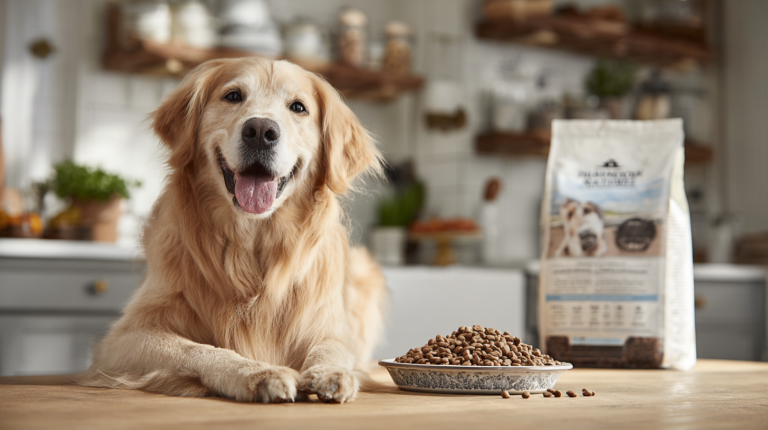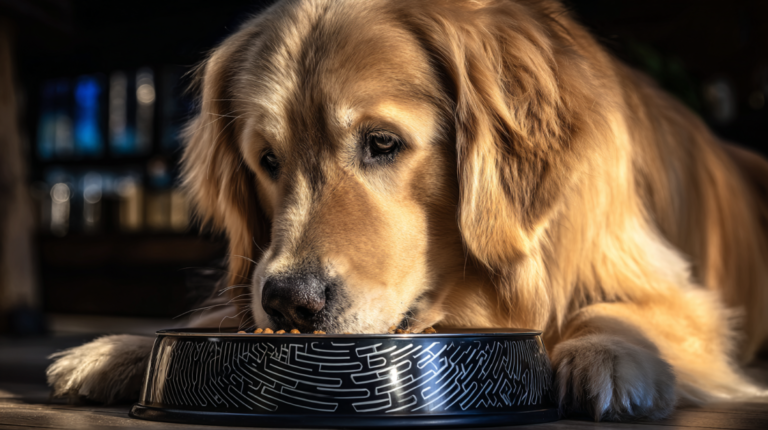Can dogs have tomatoes? Learn 5 critical facts about tomato safety for dogs, including toxic parts, symptoms, and safe feeding guidelines from veterinary experts.
Table of Contents
Picture this: You’re preparing a fresh garden salad when your furry companion gives you those irresistible puppy eyes, hoping for a taste of whatever you’re preparing. As you slice into a juicy red tomato, you pause and wonder, “Can dogs have tomatoes?” This question troubles thousands of pet owners daily, and the answer isn’t as straightforward as you might think.
Can dogs have tomatoes?
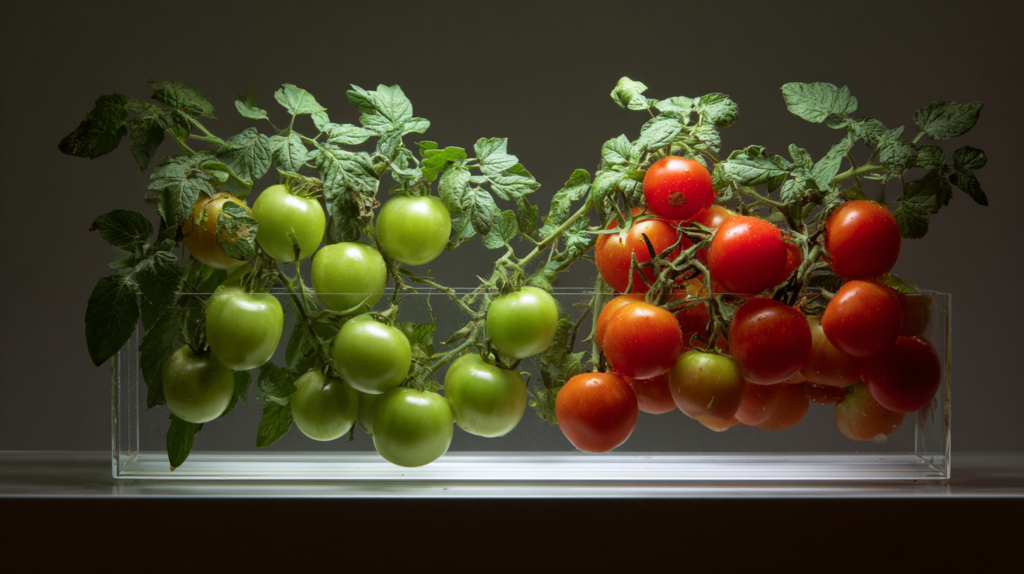
The short answer is: ripe red tomatoes are generally safe for dogs in small amounts, but there are significant risks you need to understand first. According to the American Kennel Club, while ripe tomatoes aren’t toxic to dogs, certain parts of the tomato plant contain solanine and tomatine—compounds that can be dangerous for your canine companion.
Recent veterinary surveys indicate that over 40% of pet owners have given their dogs human food without fully understanding the potential risks. When it comes to tomatoes, the devil is truly in the details. From toxic green parts to portion control, there are five critical facts every responsible pet owner should know before sharing this popular fruit with their four-legged family member.
The Science Behind Tomatoes and Dogs
Understanding whether dogs can have tomatoes requires a deep dive into plant chemistry and canine physiology. Tomatoes belong to the nightshade family (Solanaceae), which also includes potatoes, eggplants, and bell peppers. This plant family produces natural compounds called glycoalkaloids, specifically solanine and tomatine, as a defense mechanism against insects and other threats.
Dr. Jennifer Coates, a veterinary advisor and expert in pet nutrition, explains that these compounds are concentrated in the green parts of the tomato plant—the stems, leaves, and unripe green tomatoes. “The concentration of these toxic compounds decreases significantly as the tomato ripens,” she notes. “A fully ripe red tomato contains only trace amounts of these substances.”
The canine digestive system processes these compounds differently than humans. While humans can generally tolerate higher levels of solanine and tomatine, dogs are more sensitive to these alkaloids. When consumed in significant quantities, these compounds can cause what veterinarians call “solanine poisoning” or “green tomato poisoning.”
Risky Fact #1: Green Tomatoes Are Toxic to Dogs
The first and most critical fact every pet owner must understand is that green tomatoes pose a serious threat to dogs. Unripe green tomatoes contain approximately 5-6 times more tomatine than their ripe counterparts. This concentration is high enough to cause toxicity symptoms in dogs, especially smaller breeds.
Symptoms of green tomato poisoning include:
- Gastrointestinal upset (vomiting and diarrhea)
- Loss of appetite
- Confusion and disorientation
- Weakness and lethargy
- Difficulty breathing
- Abnormal heart rate
A case study from the Veterinary Emergency and Critical Care Society documented a 25-pound Border Collie that consumed approximately 10 unripe cherry tomatoes from a garden. The dog experienced severe vomiting, diarrhea, and weakness within 6 hours of consumption, requiring emergency veterinary treatment and supportive care for 48 hours.
The toxic dose of tomatine for dogs is estimated at 5 mg per kilogram of body weight. To put this in perspective, a single large green tomato can contain 42-63 mg of tomatine—potentially dangerous for dogs weighing less than 25 pounds.
Risky Fact #2: Tomato Plants Are More Dangerous Than the Fruit
While ripe tomatoes themselves pose minimal risk, the tomato plant presents a much greater danger to curious canines. The stems, leaves, and roots of tomato plants contain the highest concentrations of toxic alkaloids. Dogs who dig in gardens or chew on tomato plants face serious health risks.
Plant parts to avoid:
- Stems and leaves (highest concentration of toxins)
- Roots and root systems
- Flowers and buds
- Green, unripe fruit
Veterinary toxicologist Dr. Sarah Johnson from the Pet Poison Helpline reports that they receive dozens of calls each summer from pet owners whose dogs have consumed tomato plant matter. “The symptoms can appear within 30 minutes to 6 hours after ingestion,” she explains. “We always recommend immediate veterinary attention for any dog that has consumed tomato plant material.”
A real-world example comes from a pet owner in Colorado whose German Shepherd puppy consumed several tomato plant leaves while playing in the garden. The 4-month-old puppy developed severe gastrointestinal distress, including projectile vomiting and bloody diarrhea, requiring emergency intervention and IV fluid therapy.
Risky Fact #3: Size Matters—Small Dogs Face Greater Risks
The size of your dog plays a crucial role in determining tomato safety. Smaller dogs are at significantly higher risk of toxicity due to their lower body weight and faster metabolism. What might be a harmless amount for a Golden Retriever could be dangerous for a Chihuahua.
Risk levels by dog size:
- Small breeds (under 25 lbs): High risk even with small amounts
- Medium breeds (25-60 lbs): Moderate risk with large quantities
- Large breeds (60+ lbs): Lower risk, but still possible with excessive consumption
The Pet Poison Helpline data shows that 78% of tomato-related poisoning cases involve dogs weighing less than 30 pounds. This statistic underscores the importance of being extra cautious with smaller breeds.
Consider the case of a 6-pound Yorkshire Terrier that consumed half of a large ripe tomato. Despite the tomato being ripe, the dog’s small size meant that even the trace amounts of tomatine were sufficient to cause mild gastrointestinal upset. The owner reported soft stools and decreased appetite for 24 hours following consumption.
Risky Fact #4: Prepared Tomato Products Can Be Harmful
Many pet owners assume that if ripe tomatoes are generally safe, then tomato-based products must be safe too. This assumption is dangerous and incorrect. Prepared tomato products often contain ingredients that are toxic to dogs, even when the tomatoes themselves aren’t the primary concern.
Dangerous ingredients in tomato products:
- Onions and garlic (toxic to dogs)
- Excessive salt (can cause sodium poisoning)
- Artificial preservatives
- High sugar content
- Spices and seasonings
Tomato sauce, ketchup, and pasta sauce are particularly problematic. A single tablespoon of typical tomato sauce can contain enough onion powder to cause hemolytic anemia in sensitive dogs. Additionally, the high sodium content in most commercial tomato products can lead to electrolyte imbalances and dehydration.
Dr. Maria Rodriguez, a veterinary nutritionist, emphasizes that “the processing and additives in commercial tomato products create entirely different risk profiles than fresh, ripe tomatoes. Pet owners should never assume that processed foods are safe just because the base ingredient might be.”
Risky Fact #5: Individual Dogs May Have Unique Sensitivities
Perhaps the most important fact about dogs and tomatoes is that individual sensitivity varies significantly. Some dogs may consume small amounts of ripe tomatoes without any adverse effects, while others may experience digestive upset even with minimal exposure. This variability makes it impossible to establish universal “safe” amounts.
Factors affecting individual sensitivity:
- Age (puppies and senior dogs are more sensitive)
- Overall health status
- Existing digestive conditions
- Breed-specific sensitivities
- Previous exposure history
A study published in the Journal of Veterinary Internal Medicine found that dogs with existing gastrointestinal sensitivities were 3.5 times more likely to experience adverse reactions to new foods, including tomatoes. This finding suggests that dogs with conditions like inflammatory bowel disease or food allergies should avoid tomatoes entirely.
The variability in sensitivity is illustrated by two Labrador Retrievers from the same household. One dog regularly consumed small amounts of ripe tomato without issue, while her littermate experienced consistent digestive upset whenever exposed to even trace amounts of tomato products.
Safe Feeding Guidelines: If You Choose to Share
If you decide to offer your dog a small amount of ripe tomato, following strict guidelines is essential for safety. Remember that tomatoes should never be a regular part of your dog’s diet and should only be offered as an occasional, small treat.
Safe feeding protocol:
- Only offer fully ripe, red tomatoes
- Remove all stems, leaves, and green parts completely
- Wash thoroughly to remove pesticides and dirt
- Cut into small, manageable pieces
- Offer only 1-2 small pieces as a trial
- Monitor closely for 24 hours after consumption
- Never exceed more than one small slice per week
Size-specific portions:
- Small dogs (under 25 lbs): One cherry tomato half maximum
- Medium dogs (25-60 lbs): 2-3 cherry tomato halves maximum
- Large dogs (60+ lbs): 1 small slice of regular tomato maximum
Always introduce any new food gradually and in tiny amounts. Even if your dog has consumed tomatoes before without issue, circumstances can change, and sensitivity can develop over time.
Warning Signs Every Pet Owner Should Recognize
Knowing the warning signs of tomato toxicity could save your dog’s life. Symptoms can appear anywhere from 30 minutes to 12 hours after consumption, and early recognition is crucial for successful treatment.
Immediate symptoms (within 1-4 hours):
- Vomiting or retching
- Diarrhea or loose stools
- Excessive drooling
- Loss of appetite
- Lethargy or weakness
Severe symptoms (requiring immediate veterinary attention):
- Difficulty breathing or rapid breathing
- Abnormal heart rate or rhythm
- Confusion or disorientation
- Tremors or seizures
- Collapse or inability to stand
Delayed symptoms (6-12 hours post-consumption):
- Continued digestive upset
- Dehydration
- Pale gums
- Weakness or reluctance to move
Dr. Emily Chen, an emergency veterinarian, advises: “Any dog showing multiple symptoms after consuming tomatoes should be evaluated immediately. Don’t wait to see if symptoms resolve on their own—early intervention can prevent serious complications.”
When to Consult Your Veterinarian
Professional veterinary guidance is essential in several situations involving dogs and tomatoes. Don’t attempt to treat tomato toxicity at home—the risks are too significant, and professional medical intervention may be necessary.
Seek immediate veterinary care if:
- Your dog consumed any amount of green tomato or tomato plant material
- Multiple symptoms are present
- Symptoms persist for more than 4 hours
- Your dog is a small breed or puppy
- Your dog has existing health conditions
Contact your veterinarian for advice if:
- Your dog consumed a large amount of ripe tomato
- You’re unsure about the ripeness of consumed tomatoes
- Your dog shows any unusual behavior after consumption
- You want to establish safe feeding guidelines for your specific dog
Information to provide your veterinarian:
- Your dog’s weight and age
- Amount and type of tomato consumed
- Time since consumption
- Current symptoms and their severity
- Your dog’s overall health status
For more expert pet care tips and product recommendations, visit BlithePet.com — your trusted source for pet wellness.
Common Mistakes Pet Owners Make
Understanding common mistakes helps prevent dangerous situations. Many well-meaning pet owners inadvertently put their dogs at risk by making these frequent errors.
Mistake #1: Assuming all tomatoes are equal Many pet owners don’t realize that tomato ripeness significantly affects safety. Green tomatoes, yellow tomatoes, and orange tomatoes all contain higher levels of toxic compounds than fully ripe red tomatoes.
Mistake #2: Offering tomato products instead of fresh tomatoes Pet owners often think that giving dogs tomato sauce or ketchup is safer than fresh tomatoes. In reality, processed tomato products are far more dangerous due to added ingredients.
Mistake #3: Ignoring plant material Some pet owners focus only on the fruit while ignoring the danger posed by stems, leaves, and other plant parts. Dogs don’t naturally avoid these toxic components.
Mistake #4: Not considering dog size Treating all dogs the same regardless of size is a critical error. A amount that’s safe for a large dog could be toxic for a small breed.
Mistake #5: Dismissing mild symptoms Some pet owners ignore early warning signs, thinking they’ll resolve on their own. Early intervention is always preferable to waiting for symptoms to worsen.
Step-by-Step Emergency Response Plan
Having a clear emergency plan can make the difference between a minor incident and a serious health crisis. Every pet owner should know these steps and keep emergency contact information readily available.
Immediate response steps:
- Stay calm and assess the situation
- Determine what and how much your dog consumed
- Note the time of consumption
- Identify current symptoms
- Remove access to additional tomatoes
- Secure any remaining tomatoes or plant material
- Check your dog’s mouth for remaining pieces
- Prevent access to the area where consumption occurred
- Contact your veterinarian or emergency clinic
- Provide detailed information about consumption
- Follow professional guidance exactly
- Don’t induce vomiting unless specifically instructed
- Monitor your dog closely
- Watch for symptom development or progression
- Take notes about timing and severity
- Prepare for potential veterinary visit
- Transport safely if needed
- Keep your dog calm and comfortable
- Bring samples of consumed material if possible
- Have emergency contact information ready
Important reminders:
- Never induce vomiting unless specifically instructed by a veterinarian
- Don’t offer food or water unless advised by a professional
- Keep hydrogen peroxide on hand only for emergency use under veterinary guidance
- Know the location and contact information for your nearest emergency veterinary clinic
Myth-Busting: Separating Facts from Fiction
Several persistent myths about dogs and tomatoes continue to circulate online and among pet owners. Setting the record straight on these misconceptions is crucial for pet safety.
Myth #1: “Cooking tomatoes makes them safe for dogs” Fact: Cooking doesn’t eliminate the toxic compounds in green tomatoes or tomato plant material. While heat may reduce some alkaloid levels, it doesn’t make unsafe tomatoes safe for dogs.
Myth #2: “Small amounts of any tomato are always safe” Fact: Individual sensitivity varies significantly. Some dogs may react to even tiny amounts of ripe tomatoes, while others may tolerate small quantities. There’s no universal “safe” amount.
Myth #3: “Organic tomatoes are safer than conventional ones” Fact: Organic growing methods don’t affect the natural alkaloid content of tomatoes. Green organic tomatoes are just as toxic as conventional green tomatoes.
Myth #4: “Dogs will naturally avoid harmful foods” Fact: Dogs don’t have an innate ability to identify toxic foods. They often consume harmful substances, including green tomatoes and tomato plants, without hesitation.
These myths can lead to dangerous decisions. Always base your choices on veterinary science rather than internet folklore or anecdotal evidence.
Alternative Safe Treats for Dogs
Instead of risking your dog’s health with tomatoes, consider these safer alternatives that provide similar nutritional benefits without the associated risks.
Safe fruit alternatives:
- Blueberries (antioxidant-rich and perfectly safe)
- Apple slices (remove seeds and core)
- Watermelon (seedless, hydrating)
- Bananas (potassium-rich, in moderation)
- Carrots (crunchy, low-calorie)
Vegetable options:
- Green beans (plain, cooked or raw)
- Sweet potato (cooked, no seasoning)
- Broccoli florets (small amounts)
- Cucumber slices (hydrating and low-calorie)
Commercial dog treats:
- Freeze-dried meat treats
- Dental chews appropriate for your dog’s size
- Training treats with minimal ingredients
- Puzzle toys with healthy stuffing options
Benefits of choosing alternatives:
- No risk of toxicity
- Often more nutritionally appropriate for dogs
- Available in dog-specific formulations
- Provide variety without danger
The Bottom Line: Risk vs. Reward Analysis
When considering whether dogs can have tomatoes, the risk-to-reward ratio doesn’t favor sharing this fruit with your canine companion. The potential dangers significantly outweigh any minimal benefits.
Potential risks recap:
- Toxic alkaloids in green tomatoes and plant material
- Individual sensitivity variations
- Size-related vulnerability in smaller dogs
- Confusion with processed tomato products
- Emergency veterinary costs and stress
Limited benefits:
- Small amounts of vitamins and antioxidants
- Minimal nutritional value for dogs
- Not necessary for canine health
- Available in safer alternatives
Professional recommendation: Most veterinarians recommend avoiding tomatoes entirely. The risks are significant, the benefits are minimal, and safer alternatives are readily available. This conservative approach protects your dog’s health and your peace of mind.
Educational Table:
Markdown Version:
| Tomato Type | Toxicity Level | Safe for Dogs | Key Considerations |
|---|---|---|---|
| Ripe Red Tomatoes | Very Low | Possibly (tiny amounts) | Individual sensitivity varies; monitor closely |
| Green Tomatoes | High | No | Contains 5-6x more tomatine than ripe tomatoes |
| Yellow/Orange Tomatoes | Moderate | No | Higher alkaloid content than ripe red tomatoes |
| Cherry Tomatoes (ripe) | Very Low | Possibly (1/2 tomato max) | Size appropriate for small dogs; still monitor |
| Tomato Sauce | High | No | Contains onion, garlic, salt, and preservatives |
| Ketchup | High | No | High sugar, salt, and potentially toxic additives |
| Tomato Paste | High | No | Concentrated form with potential additives |
| Tomato Leaves/Stems | Very High | Never | Highest concentration of toxic alkaloids |
| Tomato Flowers | High | No | Contains significant levels of toxic compounds |
| Dried Tomatoes | Moderate | No | Concentrated alkaloids and often contains salt |
FAQ Section :
Q: Can dogs eat ripe tomatoes safely?
A: While ripe red tomatoes contain minimal toxic compounds, they’re not recommended for dogs. Individual sensitivity varies significantly, and even small amounts can cause digestive upset in sensitive dogs. Safer alternatives are available.
Q: What happens if my dog eats a green tomato?
A: Green tomatoes contain high levels of tomatine and solanine, which are toxic to dogs. Symptoms include vomiting, diarrhea, weakness, and difficulty breathing. Contact your veterinarian immediately if your dog consumes green tomatoes.
Q: Are cherry tomatoes safer than regular tomatoes for dogs?
A: Cherry tomatoes have the same toxicity profile as regular tomatoes. If ripe and red, they contain similar low levels of alkaloids. However, their small size makes portion control easier, but they still pose the same risks.
Q: Can dogs eat tomato sauce or ketchup?
A: No, tomato sauce and ketchup are dangerous for dogs. They contain onion, garlic, excessive salt, and preservatives that are toxic to dogs. These products are more dangerous than fresh tomatoes.
Q: How much tomato is toxic to dogs?
A: There’s no established “safe” amount because individual sensitivity varies. Small dogs are at higher risk, and even tiny amounts can cause problems. The toxic dose of tomatine is approximately 5 mg per kg of body weight.
Q: What should I do if my dog ate tomato plant leaves?
A: Tomato plant leaves contain the highest concentration of toxic alkaloids. Contact your veterinarian or pet poison control immediately. Don’t wait for symptoms to appear—early intervention is crucial.
Q: Are there safe alternatives to tomatoes for dogs?
A: Yes, many safe alternatives exist including blueberries, apple slices (no seeds), carrots, green beans, and watermelon. These provide similar or better nutritional benefits without the associated risks.
Conclusion
So, can dogs have tomatoes? While ripe red tomatoes aren’t technically toxic to dogs, the risks associated with tomato consumption make them a poor choice for canine treats. The five critical facts we’ve covered—green tomato toxicity, plant material dangers, size-related risks, processed product hazards, and individual sensitivity variations—all point to the same conclusion: it’s better to choose safer alternatives.
The complexity of tomato safety, combined with the availability of perfectly safe alternatives, makes the decision straightforward. Your dog’s health and safety should always take priority over satisfying their curiosity about human food.
Remember that every dog is unique, and what’s safe for one may not be safe for another. When in doubt, consult with your veterinarian about the best dietary choices for your specific canine companion. Your furry friend depends on you to make informed decisions about their health and wellbeing.
Have a similar experience with your pet? Share it in the comments below! Don’t forget to check out our other helpful guides at BlithePet.com for more expert pet care advice.

